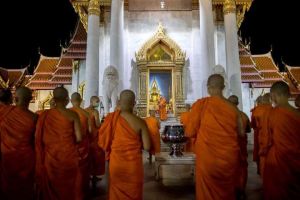ABHIṢEKA
The practice of abhiṣeka in esoteric Buddhism stands as the gateway
ceremony into the esoteric system and represents a ritual of passage
that was required for a candidate to be considered a member of the
esoteric community, authorized to perform the rituals and to say the
mantras associated with the plethora of esoteric practices.
In many ways it was unlike the Mahāyānist vows of the bodhisattva, which could have been declared through the process of visualization, with or without the presence of a consecrated bodhisattva giving the vows,
and the acceptance of bodhisattva vows was generally done without the
use of mantras or dhāraṇ īs. Conversely, the esoteric rite theoretically
required the presence of a master who had himself been consecrated,
and the abhiṣ eka additionally employed a variety of distinctive cer-
emonial activities—mandalas, mudrās, mantras, homas, etc. Because
it was seen normatively as a transfer of authority between human
generations, it had greater similarities to the two levels of ordination
(pravrajyā and upasampadā) for the monk than to the practices of the
Mahāyāna per se, and sometimes invoked the familial metaphors of
consanguinity (father-son, brothers). Since individuals did not always
have living masters, the abhiṣ eka ceremony also developed a narrative
of transmission, wherein the first human master may have received
the initial consecration from a buddha or bodhisattva in a vision, in a
miraculous manifestation, or in a dream.
The Buddhist abhiṣeka rite took its direct inspiration from clas-
sical and medieval coronation rites, although it also appropriated
some of the dynamics of abhiṣeka as a purification visualization in
Mahāyānist rituals as well. The non-Buddhist rituals on which it was
based employ the abhiṣ eka rite for several different purposes, although
the different applications of abhiṣeka are in need of further explora-
tion. Nonetheless, within discrete Indian ritual programs, abhiṣ eka had
at least six different uses: (1) as a rite of coronation, (2) as a ritual of
renewal, (3) as a metaphor signifying recognition, (4) as a ritual of
purification, (5) as a ritual of consecration, and (6) as a rite of bath-
ing images as honor given the divinity (Davidson, forthcoming[a]).
